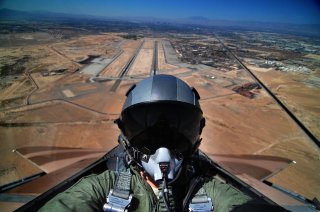ISIS Had No Chance Against American Airpower
Recently, the RAND Corporation released a report on the utility and importance of airpower in the fight against the Islamic State (ISIS).
Here's What You Need to Know: Through a combination of special operations and air power, the Coalition and its partners were successful, and the defeat of ISIS was capped with the death of Abu Bakr al-Baghdadi, its leader, during a Delta Force raid in Syria.
Recently, the RAND Corporation released a report on the utility and importance of airpower in the fight against the Islamic State (ISIS). The RAND report offers some valuable insight on the benefits of airpower against an extraordinary terrorist organization.
By 2015, ISIS had devasted the Iraqi Army and was even threatening Baghdad. With more than 40,000 fighters, ISIS controlled key Iraqi cities in the Northwest part of the country, including Raqqa, Mosul, Fallujah, and Ramadi.
A US-led international Coalition (Combined Joint Task Force Inherent Resolve) worked with the Iraqi Army and other local partner forces, such as the Kurds, to drive back the Islamist terrorists. Through a combination of special operations and air power, the Coalition and its partners were successful, and the defeat of ISIS was capped with the death of Abu Bakr al-Baghdadi, its leader, during a Delta Force raid in Syria.
Air power was crucial throughout the campaign. For example, from 2015 to 2019, Coalition aircraft dropped more than 112,000 munitions on ISIS targets. By late 2020, the Coalition had conducted more than 35,000 airstrikes.
The RAND researchers had five research questions for their study:
- What happened during the air campaign against ISIS?
- How was airpower employed?
- Was airpower effective against different ISIS target sets?
- What did air power accomplish in or contribute to the defeat of ISIS?
- What lessons should the U.S. Air Force and joint force derive from this campaign?
Here are the report’s conclusions.
First, the integration of US and Coalition special operations forces with local groups was critical in the defeat of ISIS. Like in the opening days of the war in Afghanistan, when special operations and CIA paramilitary officers embedded with local fighters and directed air power against the Taliban and al-Qaida, the integration of US and Coalition commandos with primarily the Kurdish-led Syrian Democratic Force (SDF) worked very well. The local partner forces provided the muscle necessary to hold territory, while the commandos advised them and directed airstrikes against the ISIS terrorists. Interestingly, US and Coalition airpower had to contend and comply with both the local partners’ capabilities and interests.
Second, despite its effectiveness and contribution, airpower didn’t significantly alter the timeline of ISIS’ defeat.
Third, airpower contributed but wasn’t the determining factor in the defeat of ISIS because of the terrorist group’s particular center of gravity (territory). At a certain point, ISIS held sway over a great chunk of land (almost 43 thousand square miles). ISIS’ power was derived from its ability to hold and control that land where it imposed a medieval and cruel form of Islam over hundreds of thousands of hapless people. Going back to the first conclusion, it was the Coalition’s ability to capture and hold land through its local partners that brought the defeat of ISIS.
Fourth, remotely piloted aircraft and aerial refueling aircraft were key, providing important capabilities to the air war, but as a result, were at times overburdened. For example, the Air Force conducted 332,884 air refueling sorties in the 2015-2019 period. This conclusion suggests that the Air Force needs to invest more in its drone and air refueling fleets.
Fifth, the air campaign against ISIS brought to the fore and reinvigorated skills such as deliberate-targeting and defense counterair operations, both of which hadn’t been used in real-world operations for some time.
Sixth, there were some deconfliction and authority issues between the Combined Joint Task Force Inherent Resolve and the Combined Air Forces Component Commander, resulting in a less effective air campaign.
Finally, the Coalition went out of its way to ensure that civilian casualties were kept at a minimum, which, in turn, depleted precision-guided munition as they offer the best targeting option in such an operational environment.
According to the report’s summary, “the authors find that, although airpower played an essential role in combating ISIS, airpower alone would not have been likely to defeat the militant organization. “
“Instead, the combination of air power and ground forces—led by Iraqi and Syrian partners—was needed to destroy the Islamic State as a territorial entity. The overarching strategy of Operation Inherent Resolve, which put ground-force partners in the lead, created several challenges and innovations in the application of airpower, which have implications for future air wars.”
The authors also make some recommendations to the Pentagon, such as modifying the allocation process for high-value air assets, making the target-development process more efficient, invest more in precision-guided munitions to avoid future civilian casualties, and invest more in targeteers and intelligence professionals to improve the targeting process.
Greek Army veteran (National service with 575th Marines Battalion and Army HQ). Johns Hopkins University. You will usually find him on the top of a mountain admiring the view and wondering how he got there.
This article was first published in Sandbox.
Image: Wikimedia Commons.

